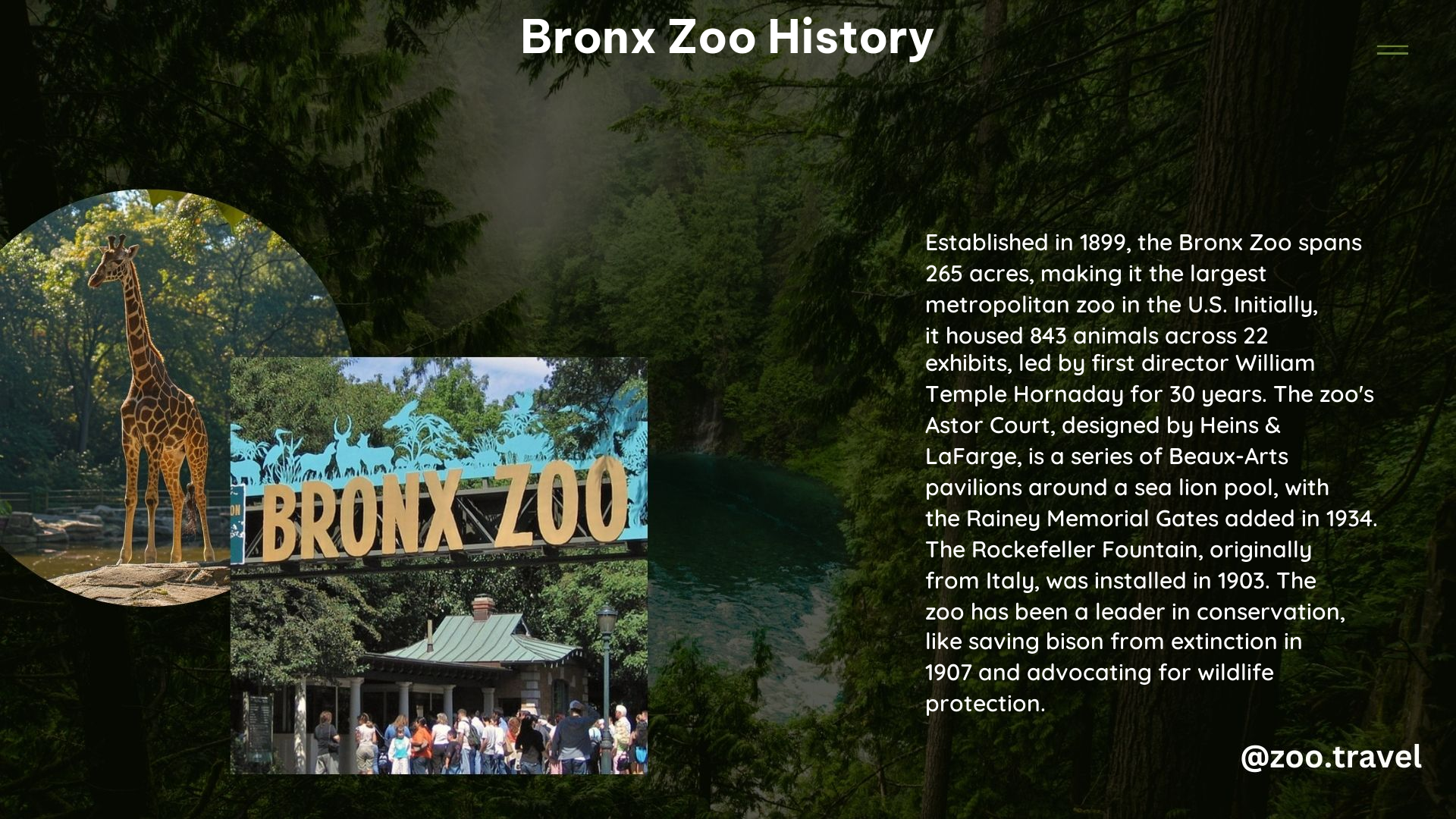The Bronx Zoo, officially known as the Wildlife Conservation Park, is a renowned zoo located in the Bronx, New York. Established in 1899, it is one of the largest zoos in the United States by area and the largest metropolitan zoo in the United States, encompassing 265 acres (107 ha) of park lands and naturalistic habitats separated by the Bronx River.
The Founding and Early Years
The Bronx Zoo was founded in 1899 by the New York Zoological Society (now the Wildlife Conservation Society) and was designed by renowned landscape architect, Frederick Law Olmsted. The zoo’s original permanent buildings, known as Astor Court, were designed as a series of Beaux-Arts pavilions grouped around the large circular sea lion pool.
The zoo’s first director, William Temple Hornaday, served for 30 years and played a crucial role in the zoo’s early development. During his tenure, the zoo became a pioneer in animal conservation, with the creation of the American Bison Society in 1905 to save the American bison from extinction. Two years later, the society successfully reintroduced bison into the wild.
Veterinary Care and Snow Leopard Conservation

The Bronx Zoo has also been a leader in veterinary care, establishing the first veterinary department in 1901. Dr. William Reid Blair, the Bronx Zoo’s first full-time veterinarian, played a crucial role in this endeavor.
The zoo has also been a leader in snow leopard care and conservation since 1903, with 80 snow leopard births, more than any other zoo in North America. This impressive record highlights the zoo’s commitment to preserving endangered species.
Controversial Incidents and Efforts to Promote Inclusivity
Not all chapters in the zoo’s history are celebratory. In 1906, the Bronx Zoo included Ota Benga, a Central African, in an exhibit in the zoo’s Monkey House before outrage from local Black ministers brought the disgraceful incident to an end. The zoo has since undertaken efforts to ensure all persons of differing races, languages, cultures, and economic status feel welcome and enjoy equal opportunity at the zoo.
Exhibit Design and Conservation Efforts
The Bronx Zoo has made strides in exhibit design, moving away from traditional cages and creating more naturalistic habitats. The African Plains habitat, which opened in 1940, was a groundbreaking exhibit that allowed animals to roam freely in a more natural setting. The zoo’s Skyfari aerial tram opened in 1973, and in 1977, the Wild Asia exhibit opened on 38 acres of previously undeveloped land, featuring a specially designed monorail that takes visitors through an Asian wild animal habitat.
The zoo is also home to the Wildlife Society, which supports conservation efforts worldwide, including Africa, and sends its animals around the country to breed. The Society has been at the forefront of conservation and field research since its earliest days, beginning with a successful effort to save the American bison from extinction in 1907.
Popularity and Accreditation
As of 2009, the zoo has an average of 2.15 million visitors each year, making it one of the most popular tourist destinations in New York City. The zoo is part of an integrated system of four zoos and one aquarium managed by the Wildlife Conservation Society (WCS), and it is accredited by the Association of Zoos and Aquariums (AZA).
The Bronx Zoo’s rich history, innovative exhibit design, and commitment to animal conservation have made it a beloved and respected institution for over a century. From its early efforts to save the American bison to its current work in snow leopard conservation and habitat preservation, the Bronx Zoo continues to be a leader in the field of zoology and wildlife preservation.
References:
– The New York Times – Bronx Zoo Apologizes for Racist Incident in 1906
– NYC Parks – History of the Bronx Zoo
– Wikipedia – Bronx Zoo
– Bronx Zoo – Historical Bronx Zoo
– Bronx Zoo – 125th Birthday Timeline
